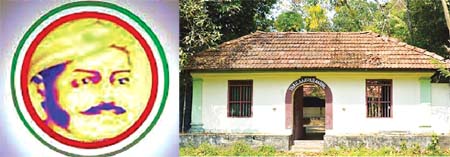Arayans traditionally led and manned the naval armies of Travancore and Cochin, while they, along with the Muslim Marikkars, formed the naval forces of Malabar. In 1808-09, the Travancore Arayans led by Velu Thampi Dalawa and Chempil Arayan revolted against the British, which was Kerala’s first revolt against the British.
Admiral of the fleet in the service of Avittam Thirunal Balarama Varma, King of Travancore, was Chempil Thailamparambil Anantha Padmanabhan Valiya Arayan Kankumaran, also known as Chempil Arayan. He was born in the Indian state of Kerala, near Vaikom, in the town of Chempu. He was a member of Kerala’s Koli community. Chempil Arayan fought in the Travancore War in 1809 under the direction of Velu Thampi Dalawa, leading an attack on Bolghatty Palace, the house of the then Company Resident, Colin Macaulay, among other things. The Resident almost escaped with his life, fleeing on a tiny boat after eluding the intruders through a tunnel. The Arayan was subsequently arrested and released after a ransom was paid; he perished in battle against the Company’s warriors.
The Bolgatty Palace, which was the residence of British Resident Col. Colin Macaulay, from which he managed to flee on a boat when Chempil Arayan invaded. The Kundara Proclamation of December 29, issued by Thampi by Velu Dalawa, Minister of Maharaja Bala Rama Varma, Maharaja of Travancore, is widely regarded as a watershed moment in the campaign for independence from the British. It is historically classified as a component of India’s first phase of independence movement.
Breaking Into Residence of the British
Various acts of intrigue and betrayal marked the run-up to this statement. It is often difficult to arrive at a value judgement on personalities who occupied the principal stages of history during times when justice and punishment might be brutal and terrible. However, history also presents us with interesting glimpses of men and women who stepped into the arena and left behind tales of bravery and fortitude. One such is Chempil Anantha Padmanabhan Valiya Arayan Kankumaran, Velu Thampi Dalawa’s chief. He was the first person to respond to the call of the proclamation and was martyred in the struggle against the British.
Chempil Arayan attempted to free his fellow countrymen who were being held captive by the British. He was apprehended and sentenced to death for treason. Despite the accusations levelled against him, Chempil Arayan seemed unfazed
Chempil Arayan’s bravery was not temporary, and he has been credited with a number of valorous deeds. Chempil Arayan is credited for breaking into the Ponjikara residence of British Resident Col. Colin Macaulay. The Resident was able to flee aboard a boat given by the Cochin navy’s commander. According to legend, Chempil Valiya Arayan gathered his soldiers and set out on a hunt for the Resident on the backwaters of Travancore in ‘odi’ boats, an adventure that was followed by a thorough search of the Valiya Arayan’s residence at Thailamparambu.
Prisoner’s Fortitude Moves Adversary
Chempil Arayan attempted to free his fellow countrymen who were being held captive by the British. He was apprehended and sentenced to death for treason. Despite the accusations levelled against him, Chempil Arayan seemed unfazed. He went so far as to respond to Col. Macaulay’s accusation (that he was implicated in the sinking of three Englishmen in the Palluruthy river) by saying that if he were free, he would gladly send the Resident’s head to the King of Travancore. According to reports, Macaulay was initially enraged, but subsequently found it difficult not to be moved by his prisoner’s fortitude and valour, and released him in exchange for a ransom.
Chempil Ananth Padmanabhan Valiya Arayan Kankumaran’s courage was not diminished by his near escape from the gallows, and according to his descendants, he answered to the call to stand up against oppression by sacrificing his life once more.
In this perspective, it is important to note that several significant events occurred on December 29, and these events merit additional investigation by historians. While Velu Thampi Dalawa’s Kundara Proclamation in Kollam was intended to alert the people of the repercussions of the British Company’s increased levy of Rs 2 lakhs on Travancore, there were virtually simultaneous insurgencies in Cochin and Kollam, where British troops were stationed.
During the days of the British East India Company in the nineteenth century, Chempil Arayan led one of the earliest uprisings against British colonialism in India, including an attack on Bolghatty Palace, the house of the then Company Resident, Colin Macaulay. The Resident almost escaped with his life, fleeing on a small boat after eluding the intruders through an underground tunnel. He was killed in a battle against the Company’s men. Chempil Arayan was well-known for his maritime exploits aboard the “Odi Vallam,” a native Kerala boat.
These nearly simultaneous insurgencies centred on intrigues in Cochin and Kollam, in which figures such as the Paliath Achan played a key part, need to be looked into more. This is only feasible when the roles played by lesser-known personalities of the time, such as the Chembil Anantha Padmanabha Valiya Arayan Kankumaran, are taken into account.
Often, evidence and facts are not representative of the whole reality, and a small ray of light on people like the Chempil Arayan might lead to surprising findings. The lives of brave souls like the Chempil Arayan certainly deserve more attention.



















Comments